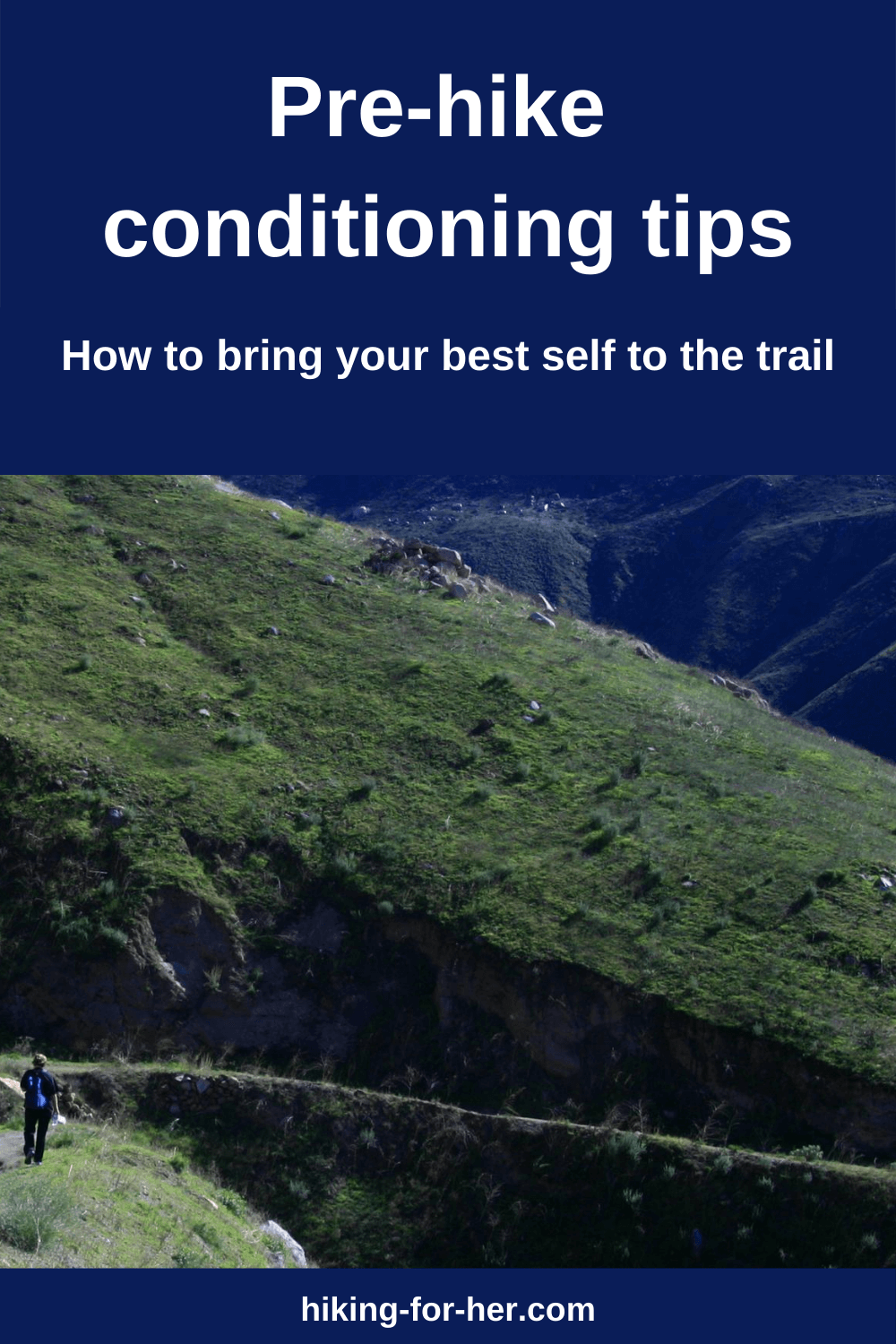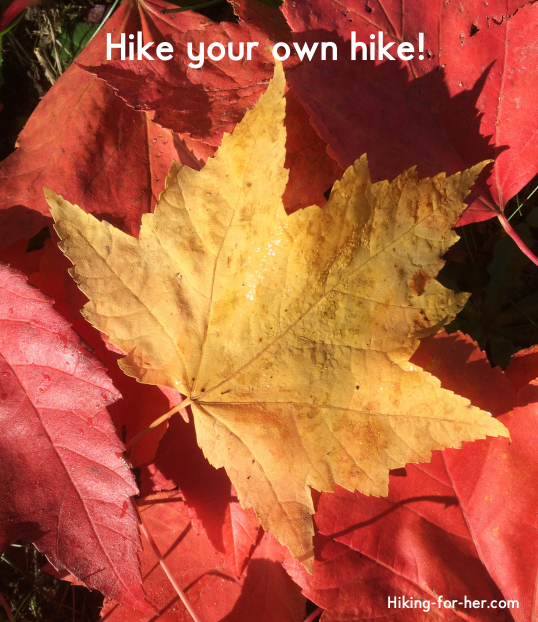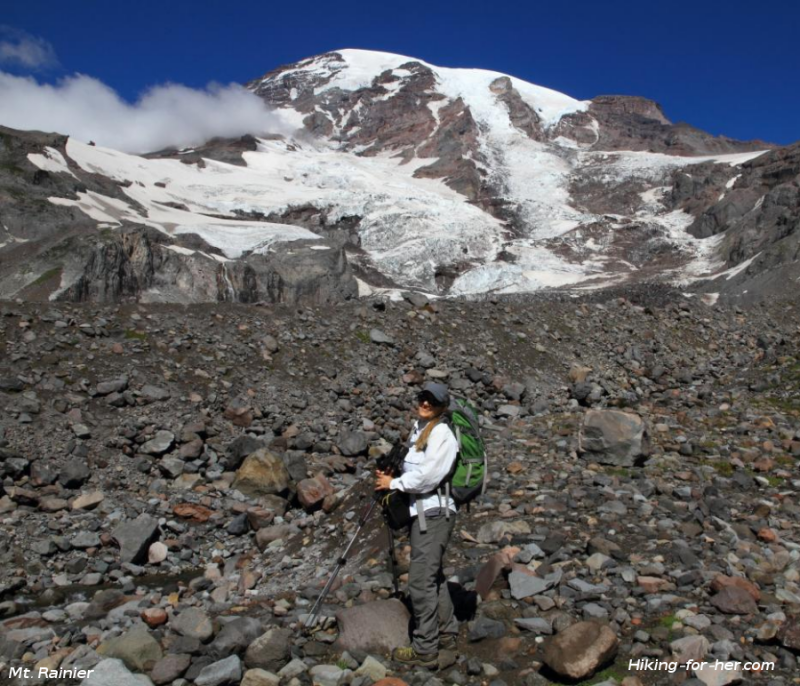Enjoy Happy Trails, the free monthly newsletter from Hiking For Her
Receive a free resource: "Hiking Layering System Explained"
Prehiking Conditioning
and Strength Tips For Hikers:
Best Ways To Prepare
By Diane Spicer
What's all the fuss about prehiking conditioning and strength?
Don't you just show up at a trailhead and start walking?
Sure, you can.
But a smart day hiker or backpacker plans ahead for the demands on muscles that may not be conditioned for uneven surfaces and a loaded backpack.
She knows that it's the best way to avoid or minimize sore muscles the next day.
So let's look at some ways to prepare your muscles for hiking.
Stretch your faithful dogs
Skeletal muscles are what I call "the faithful dogs" of the body.
You ask (or demand), they oblige.
So I feel that it's unkind to ask these faithful servants to work hard without a good stretch, both before and after a hike.
Quick and easy stretches like those I provide in that link will keep your faithful, hard working muscles less prone to aches the next day: a real concern on backpacking trips, really more of a nuisance for day hikes.
Quick thought experiment
OK, imagine that you're one of your thigh muscles.
How about one of the quadriceps, perhaps vastus lateralis?
- That's a major muscle in a large group on the front of your thigh which provide power to you on a hike.
Now imagine this:
- You've been at rest in the passenger seat of a car for the last two hours, while traveling to a trail head.
- Suddenly, you're walking toward that trail head, feeling the weight of a backpack and the urgency of sudden movements along the length of your skeletal muscle fibers.
- You'll be expected to perform maximally without complaint for the next four hours, with only brief rest stops.
Now imagine: What would your dearest wish be as you head out onto the trail?
A good long stretch, of course!
More stretching resources for hikers
Need back stretches specifically? Read this.
Another resource to check out:
Bob Anderson's book will get you started on a lifelong habit of stretching.
If you're over 50 years of age, use this version instead.
What else can you do for
prehiking conditioning?
Pay attention to the quirks of your own body, and how you hold yourself against gravity.
Proper body mechanics are important for avoiding backaches or neck strain, whether off or on the trail.
It doesn't matter how faithful you are when it comes to prehiking conditioning and strength if you tweak a muscle during a hike, right?
So start small. Set your phone or watch timer at random intervals and take note of your posture.
- Are you slumped in a chair, with an odd twist to your neck?
- Are your shoulders curved forward?
- What's your lower back saying to you?
Sounds like a pain to notice, and correct, how far you thrust your jaw out?
Or how you pick up your backpack every time?
- The pain of NOT doing these things overshadows the inconvenience of doing them routinely.
Hydration levels are critical
Water intake also plays a role in your conditioning level, as a vital nutrient for muscle cells.
Here's the watery reality:
All of the biochemical reactions happening to make your muscles contract and relax, over and over again on a hike, need water to happen.
Track how much water, just plain old water, you drink in a day. You might be surprised!!
Hydration tips to incorporate into your routine here:
- Hiking water and its importance
- Choose your water bottles with care
How to whip your muscles
into shape for hiking
We've covered the easy stuff: paying attention, drinking enough water.
Now let's get physical.
Cross training can be useful and fun for building prehiking strength and conditioning.
And it really pays off on a hiking trail in terms of endurance.
A few suggestions for hikers:
- Try biking (indoors when the weather is crummy) for double digit miles at least once a week. Your leg muscles will be so much stronger that you'll float up the trails that used to slow you down.
- Swim to give your arms and shoulders a good workout, very useful for preparing for a long backpacking trip.
- Dance. Turn on the tunes and dance vigorously around the house as you mop, vacuum or sweep.
- Brisk daily thirty minute (or more) walks, including some inclines and uneven terrain (avoid full time pavement, in other words), will keep your lung capacity and muscle tone at adequate levels.
And after these vigorous aerobic activities, enjoy lying on the floor to give all of your large muscle groups a good stretch (you knew that was coming, didn't you?).
- Pilates or gentle yoga stretches like child's pose feel great!
It's fun to watch your level of fitness improve, day by day.
Get really serious about
prehiking conditioning and strength
Need a structured approach to conditioning for the trail?
Maybe because you've got an upcoming backpacking trip?
Or want to try more demanding hikes?
- REI has a thorough article here for you, including a weekly schedule and training exercises.
Be flexible
Ever notice how stiff you feel after a rest break on the trail?
Or the morning you crawl out of your sleeping bag on the second day of a backpacking trip?
For increasing your flexibility, an oft ignored component of hiking success, I have one word for you:
yoga
Ease into things with yin yoga
Yin yoga holds just a few poses in an hour long session, using bolsters and blocks and pillows and blankets, along with soothing music and a relaxed setting.
So very restorative when your body aches! And it opens up your joint spaces in a safe manner, allowing your muscles to elongate while your mind relaxes.
- This is the book I use to put together my own routines at home: Yin Yoga: Stretch The Mindful Way by Kassandra Reinhardt.

Build up to this type of yoga
Vinyassa flow yoga is more dynamic and vigorous.
You warm up first, then do a series of poses according to cues from the instructor.
Then you move into “flow” sequences, according to your own strength and balance.
The 50 minute session ends with a cool down and a short period of complete relaxation.
This style of yoga is a great way to tone up muscles, build core strength, and have some fun.
I’ve been doing this style of yoga and have much better balance and spine flexibility, not to mention more upper body strength (thanks to downward facing dog and plank position).
Free yoga resource for prehiking
conditioning and strength
There are many types of yoga courses available for free on YouTube.
I really trust this particular instructor: https://www.youtube.com/user/yogawithadriene
Attitude is all for a hiker
What you tell yourself about the importance of physical conditioning truly matters.
When you hear yourself thinking “I have to go” for a 30 minute walk today, realize that you can go (not “should” go) for a walk because it feels good, builds muscle and aerobic capacity, and relieves stress.
Then tell yourself that you want to go because it’s one day closer to your next hike!
My best tip:
Always go back to first principles when you’re not enthused about conditioning:
- a strong body makes a hike or backpacking trip more enjoyable and safer
Conditioned muscles will feel less achy and perform better, too.
And you'll look good in your hiking pants ;)
A few personal tips for
improving your hiking fitness
See if any of these approaches make sense for you.
Two or three times a week, schedule permitting, I do a thirty minute workout on home gym equipment (not being really keen on sweating in public, except while hiking).
- I include resistance training and weight
lifting.
- Listening to music or news programs keeps it from getting dull.
I try to park far away from store entrances, regardless of weather or how many packages I'm carrying.
I use the stairs every time, being secretly very proud of my "never-use-the-elevator" status.
I walk up escalators, or take the staircase right beside it.
I try to stand up a lot and move around during the day.
- This is not
hard while I'm being active, but requires a bit of mental discipline when
I'm deep into a project at my computer.
- I set an alarm on my phone to remind me to take stretch breaks.
And I hike or snowshoe every week-end, with multiple-day trips whenever possible. That's my favorite way to check whether or not my prehiking conditioning and strength approaches are working!
Did any of those suggestions seem reasonable, like something you could fit into your daily routine?
Prehiking conditioning
and strength summarized
To sum up, I take my "faithful dogs" out for daily romps in preparation for weekend day hikes and longer backpacking trips.
They love it, and so do I.
The hidden motive here is a consistent fitness level as well as injury prevention:
- Back injuries rob you of trail time.
- Sore feet along with achy knees erode your mental clarity on a hiking trail.
- Dealing with hiking inflammation is tedious.
- And rehabbing a hiking injury can get expensive in terms of both time and money.
So my advice is to invest some time now, every day, in prehiking conditioning and strength building, so you can enjoy trail time well into your golden years as an elder hiker.
It's the smart way to hike!
Home page > Best Hiking Tips >
Tips For Prehiking Conditioning & Strength



